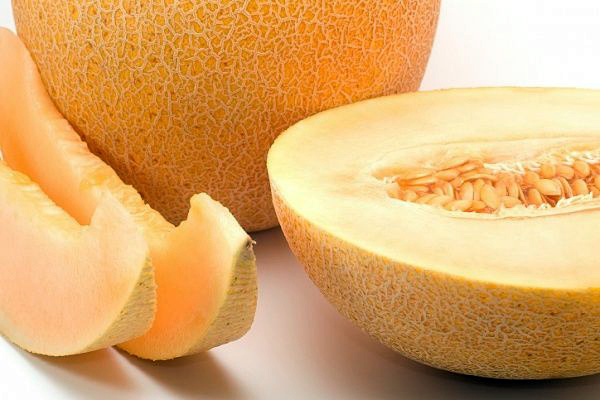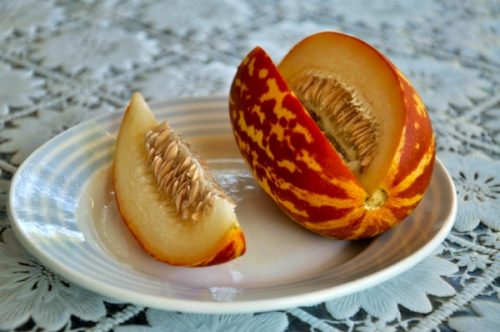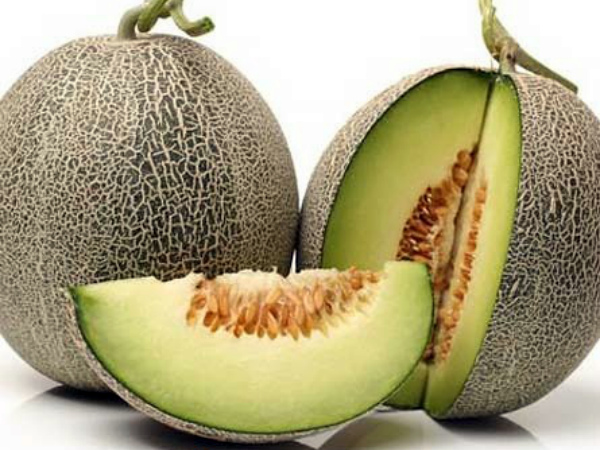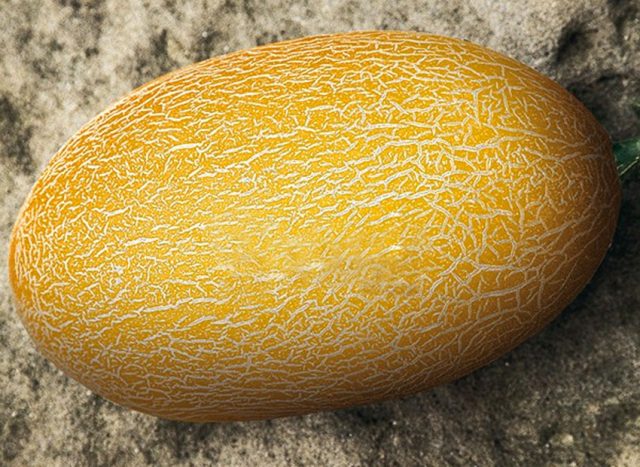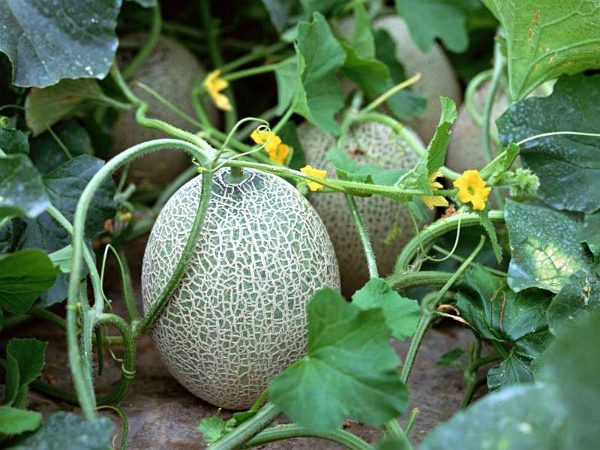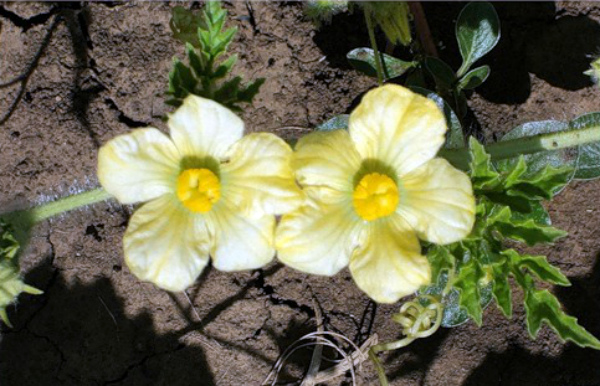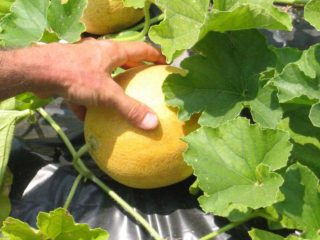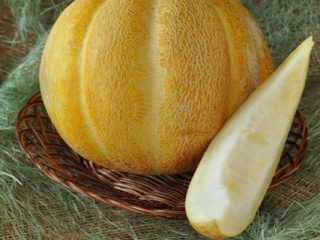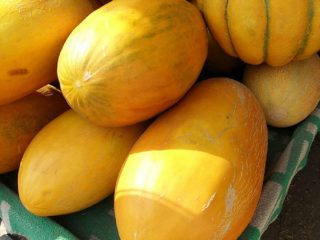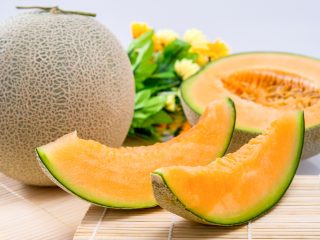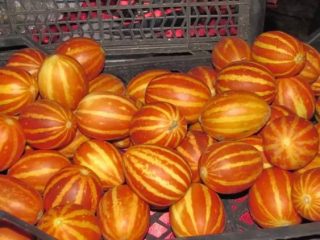Content
Pineapple melon is very popular due to its simplicity in care and excellent taste. Every gardener can enjoy delicious fruits that taste like overseas fruits. It is enough just to purchase seeds and plant them in your personal plot.
Description of pineapple melon
Pineapple melon is a high-yielding mid-season variety. Heat-loving culture, very demanding of light. The period from germination to full ripening is 80-100 days.
Key Features of Pineapple Melon:
- fruit color - yellow-golden;
- the rind is dense, but not thick, with a slight mesh pattern;
- the pulp is tender, juicy, slightly oily, light cream in color;
- shape - rounded, slightly oblong;
- fruit weight - 1-3 kg;
- bright pineapple aroma.
Pineapple melon is perfectly transported, even over fairly long distances, and is well stored. The shelf life of the removed fruits is 1.5-2 months, without any chemical treatment. The variety is perfectly adapted to any weather conditions, in particular, it easily tolerates a temporary drop in temperature.
Pineapple melon is consumed both fresh and processed. Jams, jams, jam, candied fruits, marmalade, juices and compotes are made from ripe fruits. Used for a variety of baked goods. You can also freeze it for future use to enjoy delicious fruit all year round.
The large amount of vitamins in pineapple melon makes it very healthy. It is recommended to introduce it into the menu for people suffering from cardiovascular diseases, diseases of the upper respiratory tract and gastrointestinal tract. It is also useful to use this fruit for anemia, anemia, gout, tuberculosis.
Pineapple melon varieties
Based on the Pineapple Melon variety, several hybrids have been bred that have similar characteristics, in particular, the taste and aroma reminiscent of pineapple. But they all differ in terms of ripening, size, shape, color of the peel and pulp.
Melon pineapple F1
Melon Pineapple F1 is a mid-season pineapple-type hybrid. The growing season lasts 90-100 days. It is characterized by a friendly yield and stable, long-term fruiting. The fruit is very sweet and fragrant, round-oval in shape. Average weight 1.3-2.3 kg. The pulp is creamy white. The peel is thin, yellow-green, with a pronounced mesh pattern.
Melon pineapple americano
Melon-pineapple Americano is an ultra-early hybrid that differs from other varieties in its miniature size and original color, as can be seen from the photo. The average fruit weight is 400 g.
Melon Americano not only has a delicious pineapple flavor, but also an attractive appearance. The light orange skin with dark brown stripes looks very unusual and decorative. The pulp is white, firm and at the same time very juicy.
Melon American Pineapple
American pineapple is a mid-season hybrid. Suitable for outdoor cultivation. Differs in high productivity, is not afraid of late spring frosts. The shape of the fruit is round, weight is about 2.5 kg, the color of the peel is light green or beige. The pulp is creamy, juicy, sweet, and tastes like pineapple.
Pineapple melon Gold
A mid-season hybrid that is easily recognizable by the greenish color of the peel, with a slightly rough surface. The color of the fruit pulp ranges from bright yellow to orange, sometimes even reddish, with a characteristic green rim at the base of the skin. The taste of the variety is excellent, with a pronounced pineapple aroma. Melon Gold is very sweet, sometimes too sweet. For those who do not like sweets, the taste of the fruit may seem very cloying.
Growing pineapple melon
In the southern regions, pineapple melon can be grown by direct sowing of seeds into the ground. In areas with cooler climates, it is better to use the seedling method of cultivating the variety.
Seedling preparation
It is recommended to start sowing with the preparation of seeds, which should be soaked in warm water for several days. It needs to be changed daily. As soon as the seeds begin to "peck", they can be sown in the ground. The first half of April is considered the best time for sowing.
Sowing is carried out in specially prepared containers, laying out 1 seed each. An important condition is the creation of a greenhouse effect, for which crops are covered with plastic wrap. They remove it immediately after the first shoots appear. The cups with emerging sprouts are placed in a well-lit place, for example, on a windowsill on the sunny side. You can prevent the seedlings from pulling out by regularly rearranging and turning the pots.
After 30 days, the seedlings can be planted in open ground. It must be pre-hardened by taking it out daily in the open air. You should start with a few minutes, constantly increasing the time.
Selection and preparation of the landing site
Pineapple melon is unpretentious to growing conditions. It grows on any soil, but the best yield can be obtained by growing the crop on neutral soils. When choosing an area for planting, you should give preference to sunny, well-lit areas, protected from cold winds.
Landing rules
You should start planting pineapple melon, focusing on the ambient temperature. The approximate date of sowing seeds is the end of spring, the last decade of May. One of the main parameters is the degree of soil heating. The soil temperature should be at least + 15 ° С, otherwise the seedlings can simply not wait.
Don't plant the seeds too deep. The optimum embedding depth is 15-20 mm. You can speed up the germination of seeds by covering the holes with crops with a film. Immediately after emergence, it is harvested.
It is recommended to plant pineapple melons at a distance of 80-100 cm from each other, since the variety tends to grow intensively.
Watering and feeding
Pineapple melon needs regular watering. The recommended water consumption rate is 500 ml for each bush. As the plant grows, this volume gradually increases to 3 liters.
Watering frequency is reduced during flowering. During this period, the melon is watered no more than once every 3-5 days. Even less often, the bushes are watered during the ripening of the fruits. Stop watering pineapple melons 7-10 days before the start of fruit picking.
It is convenient to combine watering with top dressing. Fertilization of pineapple melons is carried out in several stages:
- 2 weeks after planting seedlings in the ground. Under each bush, add 2 liters of nutrient solution (20 g of ammonium nitrate per 10 liters of water).
- During the budding process. Fertilize with ammonia solution or mullein (1:10).
- 2-3 weeks after the second feeding, the bushes are poured with a complex of mineral fertilizers. The solution is prepared in this way - 50 g of superphosphate, 30 g of ammonium sulfate, 20-25 g of potassium salt are dissolved in 10 liters of water.
Formation
Pinching the lashes is the main agricultural technique that affects the yield of pineapple melons. Their fruits are tied on lashes of the third order. After the first 4-5 true leaves appear at the shoot, pinch the top of it over the third leaf. Over time, second-order shoots will begin to grow from the axils of the remaining leaves.
After 4-5 leaves appear on them again, the lower shoot should be removed, and the tops should be pinched off the top two. On them, shoots of the third order will grow, on which flower stalks will appear (in the photo), and then the fruits of pineapple melons will be tied.
When the size of the ovaries reaches 4-5 cm, the weakest branches should be removed, leaving only 5-6 on which the largest ovaries are located.
Harvesting
You should start harvesting after making sure that the pineapple melons are fully ripe. First of all, attention should be paid to the color of the fruit and to the mesh on the surface of the peel. Ripe pineapple melons are easily separated from the lashes, have a characteristic color, a network of cracks is evenly distributed over the entire skin. But, such fruits should not be left for storage, since they will not lie for more than 1-1.5 months.
For long-term storage, it is recommended to select melons with a moderately pronounced network of cracks, covering no more than half of the fruit. Such fruits are collected selectively, as they show signs of technical ripeness. Harvesting is done in the morning, before the onset of heat or in the evening. Plucked pineapple melons are left in the garden for 4-5 days, turning from side to side every 5-6 hours. Then they are removed to a dry, cool room.
Diseases and pests
Pineapple melon is resistant to powdery mildew, late blight and other fungal diseases. But sometimes it is exposed to the occurrence of diseases characteristic of other melons and gourds.
Diseases and pests | Signs of the disease |
Melon aphid | Located on the back of the leaves, sucking juice from the plant |
Wireworm | Drills holes in fruits, laying eggs inside |
Copperhead | Pink spots on the surface of the leaves |
Spider mite | A thin cobweb on the underside of the leaves, which subsequently spreads throughout the bush |
Scoop | It feeds on fruits, leaving deep holes in their surface |
Melon fly | Lays eggs inside the fruit, causing them to rapidly rot |
Fusarium | Affects primarily young shoots, the leaves and stems of which lose their natural color |
Powdery mildew | Leaves and stems are covered with white bloom |
Downy mildew | All parts of the plant are covered with a yellow bloom. |
Preventive actions:
- During planting, onion skins or eggshells must be placed in each hole.
- Carry out periodic spraying of the bushes with a solution of laundry soap or ash, whey, onion and garlic broth.
- Plant scented plants such as marigolds around the pineapple melon area.
Reviews of pineapple melon
Conclusion
Pineapple melon will appeal to both adults and children due to its original taste and aroma. The variety is unpretentious, it can be grown both in greenhouse conditions and in garden beds. Suitable for growing in any latitude, fruit setting takes place even in stressful climatic conditions.
